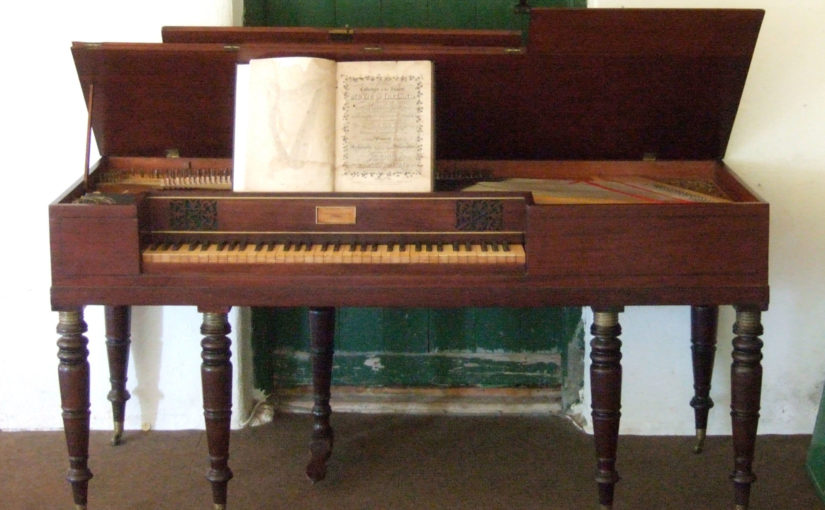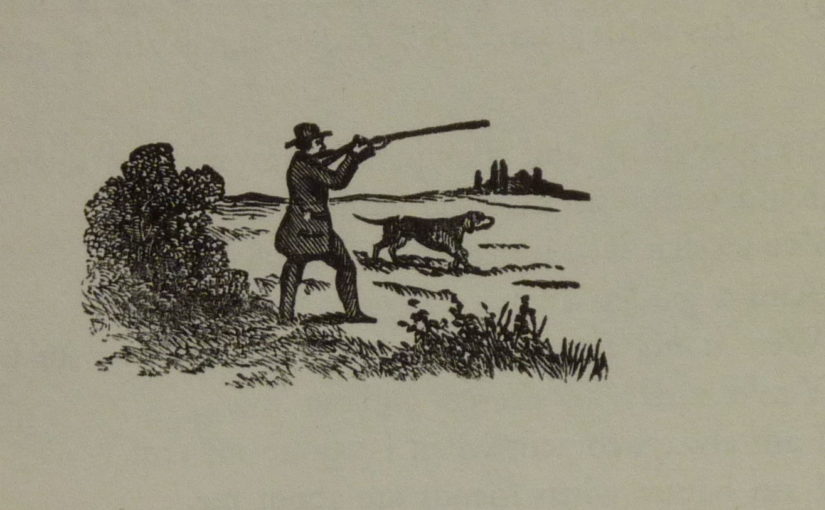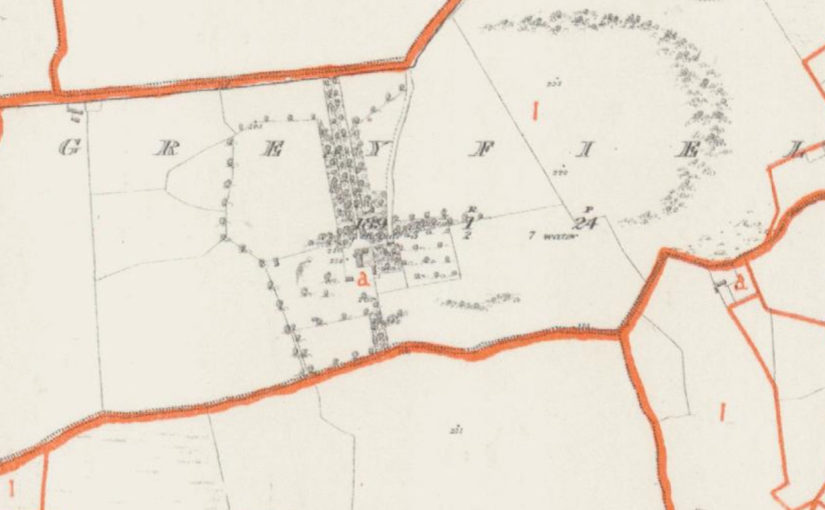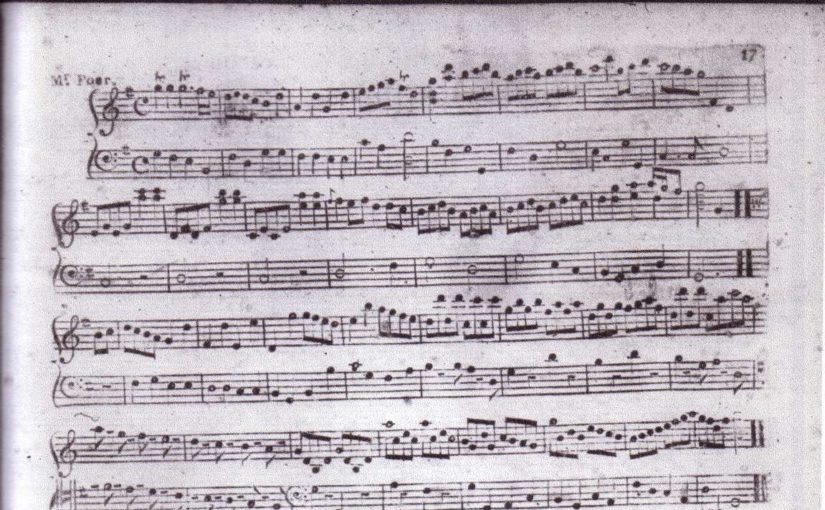Edward Bunting wrote a song with a full piano arrangement into one of his collecting pamphlets, probably in the summer of 1792. I was going to silently pass over these pages as part of my Old Irish Harp Transcriptions Project, but I thought that actually this is an interesting enough thing to do a post about it.
Continue reading The Weaver’s LamentationCategory: repertory
Eleanor Plunkett
Carolan’s song addressed to Eleanor Plunkett, which begins “A Nelly an chúil chraobhaigh”, is fairly well known nowadays.
Continue reading Eleanor PlunkettMailí Bhán
When I started playing the harp, I worked through Ann Heymann’s book Secrets of the Gaelic Harp (Clairseach, 1988). The first tune that I learned from this book was Mailí Bhán, “fair Molly”.
Continue reading Mailí BhánBroderip & Wilkinson, the Compositions of Carolan
One of the source books used by Donal O’Sullivan for his Carolan in 1958 is the enthusiastically titled A Favourite Collection of the so much admired old Irish Tunes, the original and genuine compositions of Carolan, the celebrated Irish Bard. Set for the harpsichord, violin, and German-flute, published by John Lee in Dublin. There is no date on this book, and O’Sullivan suggests 1780.
Continue reading Broderip & Wilkinson, the Compositions of CarolanEdward Dodwell
Edward Dodwell is another of the tunes in the “difficult” section of Edward Bunting’s field notebook between pages 14-40. You can see in my tune list spreadsheet that Ned Dodwell, on p.40, is at the very end of that section. In fact, since the next facing page from p.40 is p.43, I think we are missing a page here, and I think the missing page had a neat copy of Ned Dodwell.
Continue reading Edward DodwellMrs. Anne MacDermot Roe
Edward Bunting made what looks like a live field transcription of a tune titled “Mrs McDermottroe” or “Nanny O Donnely” on p. 18/18/27/f8v of Queen’s University Belfast, Special Collections MS4.29. Bunting made an edited neat copy on the facing page, and he published a piano arrangement in his 1797 book (No.53, Anna ni ciarmuda ruaidh / Nanny McDermotroe / Carolan). There don’t appear to be any independent variants of this tune, so the only way to understand it is to analyse Bunting’s very unsatisfactory notations.
Continue reading Mrs. Anne MacDermot RoeBunting tune collecting statistics
As I work on the transcriptions project I am also assembling a spreadsheet of tunes and metadata to try and get a grip on attributions, variants, and titles.
Continue reading Bunting tune collecting statisticsUsing medieval harps to reconnect to 19th century tradition
As the old tradition came to an end in the first years of the 19th century, the old harpers who were the tradition bearers seem to have played harps that were made in the first half of the 18th century. Denis O’Hampsey died in 1807; his harp was made in 1702. Patrick Quin was still alive in 1811; his harp is dated 1707 though some people argue that it is much older. The last dated instrument in the old tradition I know of is the Bunworth harp, made in 1734. There are later references to harps being made; Arthur O’Neill talks about going to the harpmaker Conor O’Kelly to oversee the completion of an instrument, which would have been after about 1750. And William Carr, who was by far the youngest of that last generation of tradition bearers, mentions having a rather poor quality harp made for him by a carpenter, apparently in the late 1790s.
All of the harps we know about that were played in the continuing tradition at the end of the 18th century and into the 19th century were large, mostly high-headed instruments. We don’t actually know what kind of harps were used by the first generation of revival students taught by Arthur O’Neill in the early 19th century; but the second generation of charity school students from 1819 on played on the big wire-strung ‘hybrid’ Irish harps made for the Belfast Harp Society by John Egan. Some of these students continued playing their big ‘hybrid’ harps down to the 1880s.
Yet the wire-strung harps made for revival purposes from the 1890s onwards don’t look back to Egan’s hybrid wire-strung harps, and they don’t even look back to the 18th century harps played by the last of the tradition-bearers. Instead, the models were the medieval Trinity College harp and the Queen Mary harp.
I really noticed this in May when I was gathering images for my Discovery Day talk. The centrepiece of the talk was our current method for re-connecting to the end of the tradition, by getting a replica of Quin’s or O’Hampsey’s harp, studying posture and hand position from Quin’s or O’Hampsey’s portrait, and working through the field transcriptions of Quin’s and O’Hampsey’s playing.
But the images of revivalists from the 1890s to the 1970s all showed small medieval harps.

Equally interesting is the way these harps were used. The slide of the Glen harp is revealing, showing Kate MacDonald playing with the harp on her right shoulder, and held very high, in a classical style and technique.

The Dolmetsch harp is shown with a photo of Edith Taylor; though we know she played left-hand-treble in the old style, what I have found about her music suggests she was playing classical-style arrangements of the “songs of the Hebrides”. Mabel Dolmetsch used one of these medieval style Irish harps to play tunes from Bunting’s piano arrangements in the 1930s.
Chris Warren’s picture is especially interesting. He was explicitly working to re-connect to the end of the tradition in the 1790s and early 1800s; he worked on the “harp music in the Bunting collection”, but he used a copy of the medieval Trinity College harp.
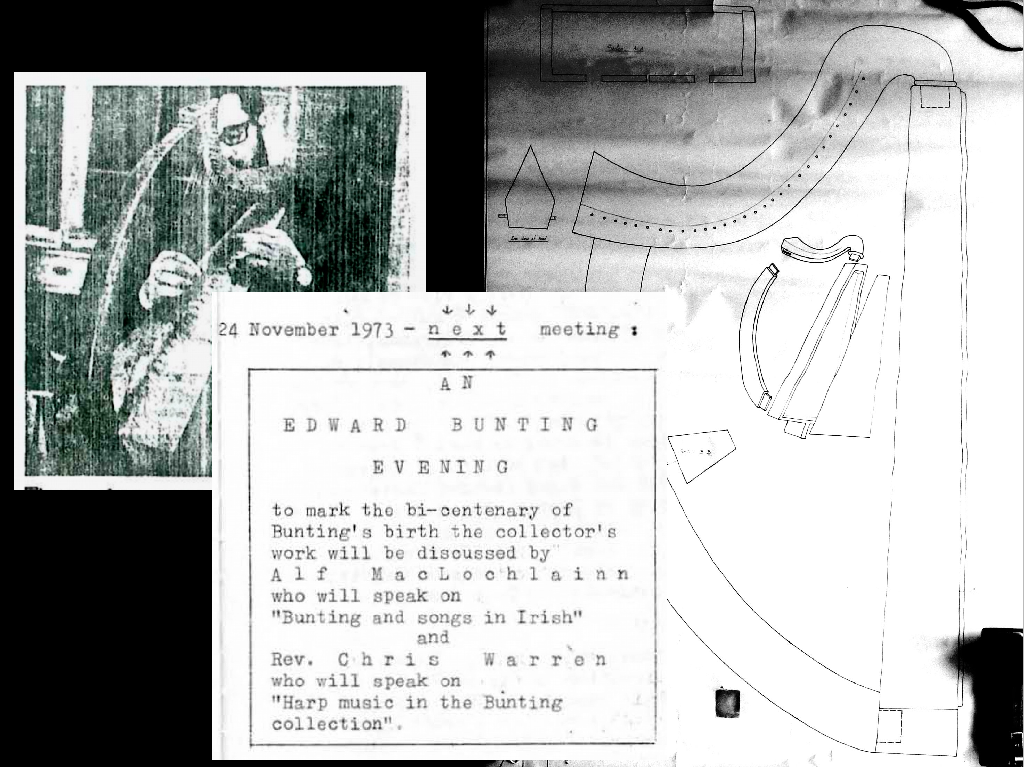
It was only with Ann Heymann in the later 1970s that we saw someone getting a copy of first Quin’s harp, and then O’Hampsey’s harp, and studying Bunting’s manuscripts with the transcriptions of the old harpers’ playing.
What is going on here? I think this is connected to the harp as symbol, vs. the harp as working instrument. The Trinity College harp as the national symbol, gave it a much stronger resonance, than the 18th century harps as the working instruments of the last tradition-bearers 200 years ago.
We need to do more research on this, to find out if anyone else was taking the big 18th century style harps seriously before Ann; and to correlate better the playing style, idiom, repertory and instrument choices of different revivalists over the past century or more.
Carolan tune collation
Donal O’Sullivan’s book, Carolan: The life times and music of an Irish harper was published in two volumes in 1958. It presented a biography, and 213 tunes presented as corrected typset melody lines, and also with quite detailed notes on each tune including some lyrics. This book has defined Carolan studies ever since, and the book has been reissued a couple of times, and there have also been derivative works.
I think there are a number of big problems with this book, which have never been addressed to my knowledge. One is that Donal O’Sullivan’s edited versions of the melody have become used as sources for performance, even though many of them are arbitrarily changed from the early source versions. Another problem is that O’Sullivan relied heavily on late fiddle and pipe sources, rather than respecting earlier harp transcriptions. Thus he also ignored harp idiom in the early sources including key, basses and ornamentation.
He also was very hasty to associate titles, lyrics and melodies, sometimes making demonstrable errors. He also included every tune he could find that had even the slightest hint of an association with Carolan, only marking the most unlikely with an asterisk to show their doubtful status. This system has been continued in the 2001 Ossian re-issue of O’Sullivan’s book, which includes new material not available to O’Sullivan. Catríona Rowsome’s 2011 book uncritically accepts all of O’Sullivan’s suggestions and the 2001 additions, giving a corpus of 226 tunes.
To Donal O’Sullivan’s credit, he did include references for all of his source material. However his referencing system is very tricky to use, with sources given by index letters, requiring constant cross-checking between pages and volumes. Also, many of his sources are still not easily available in facsimile.
I have been working on a collation of all the different versions of each of the tunes attributed to Carolan. I have entered all the information from Donal O’Sullivan’s book into a spreadsheet, and tried to unpick the different strands presented. I have put the spreadsheet here on Google Docs for you to look at and interact with.
You can use the spreadsheet to sort by source, or by Donal O’Sullivan’s number. I have also put a tentative rating beside each tune, to show how likely I think that Carolan had anything to do with the tune. These can be edited later if new information comes to light.
Rather shockingly, only a bit over half of the tunes have a solid and reliable attribution to Carolan; about 1/4 are almost certainly spurious.
There’s a lot more work to be done on this, and in time I will update the spreadsheet. But I thought it was in a useful enough state at the moment to show it to you,
Failte Mhic Mhuirich
I was in Edinburgh on 28th April 2018, to see the Lord Lyon King of Arms and one of his Unicorn Pursuviants presenting Dr. Robert Currie with his commission as Commander of the Name and Arms of Currie. Continue reading Failte Mhic Mhuirich
